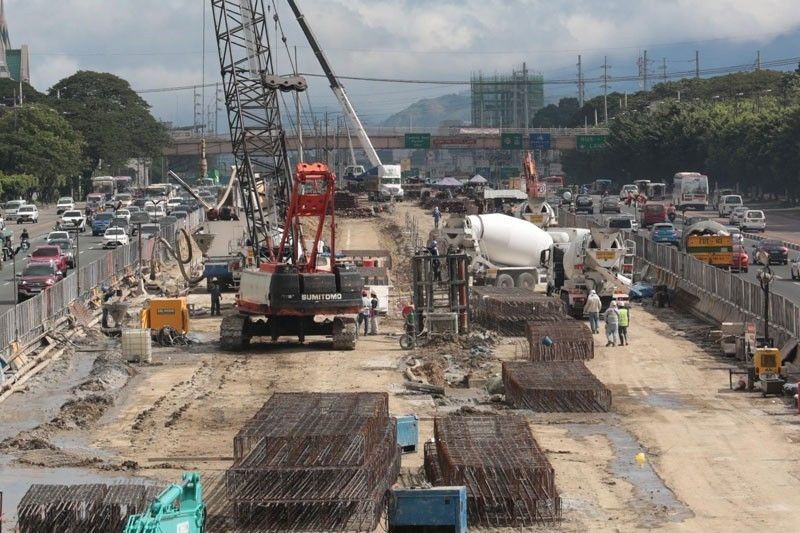Pandemic slows down momentum of flagship infrastructure projects

(Conclusion)
MANILA, Philippines — Another vital component of the Luzon Spine Network is the Southeast Metro Manila Expressway, a 34-kilometer highway linking Metro Manila to the province of Rizal. The toll road will connect Skyway/FTI in Taguig City to the Batasan Complex in Quezon City, and is expected to reduce travel time from Bicutan to Batasan to 26 minutes from one hour and 50 minutes.
The government further aims to link NLEX to the South Luzon Expressway through an eight-kilometer Connector Road from C3 Road in Caloocan to the Polytechnic University of the Philippines in Manila. The toll road will follow the common alignment of Skyway Stage 3, effectively cutting travel time between SLEX and NLEX to 20 minutes from the previous two hours.
For the southern portion of Metro Manila, the infrastructure program includes the Ninoy Aquino International Airport Expressway Phase 2. The project consists of a 14.85-km elevated expressway with four lanes, from the endpoint of NAIA-X Phase 1 all the way to PAGCOR Entertainment City. It is expected to cut travel time by a third to eight minutes from 24 minutes.
A key project in the south is the 45.29-km Cavite Laguna Expressway, which will connect the Cavite Expressway and SLEX-Mamplasan interchange in Biñan, Laguna, thereby cutting travel time from CAVITEX to SLEX by half to 45 minutes.
Another project is the Laguna Lake Highway, spanning 6.94 km complete with a protected bike lane and sidewalk, as well as the construction of the two-lane Napindan Bridge. This could cut travel time from Taytay, Rizal to Bicutan by half to just 30 minutes.
Meanwhile, the C-5 South Link Expressway will run a length of 7.7 km with six lanes from R-1 Expressway to SLEX, reducing travel time between the two points to 10 minutes from 40 minutes.
Outside the LSEN, a key project in Luzon is the Bataan-Cavite Interlink Bridge, which will run a length of 32.15 km. Once completed, the bridge could link the two provinces in just 40 minutes, from the current travel time of five hours.
In the Visayas, the infrastructure program involves the Panay-Guimaras-Negros Link Bridge at 32.47 km, the Cebu-Mactan Bridge and Coastal Road Construction Project at 3.3 km, and the Panglao-Tagbilaran City Offshore Connector Bridge at 2.71 km.
Meanwhile, Mindanao has three infrastructure projects including Panguil Bay Bridge (3.17 km), three Tawi-Tawi bridges (1.24 km) and the Samal Island Davao City Connector Bridge (3.98 km).
While the Duterte administration has a good and ambitious infrastructure blueprint, it needs to spend more on infrastructure and not just rely on the private sector, experts said.
In 2020, public infrastructure spending fell by over a fifth to P681.1 billion.
Data from the Department of Budget and Management’s (DBM) showed disbursements on infrastructure and other capital outlays last year dropped 22.8 percent to P681.1 billion from P881.7 billion in 2019.
However, Villar said that as a percentage of gross domestic product, infrastructure spending grew to 5.4 percent in 2019, or before COVID-19 struck, from 4.9 percent in 2018.
The goal is to even grow this further in the years to come, he said.
Observers said the government should have allowed public construction to proceed especially during the lockdowns when there were very few motorists, some observers said.
The good news is that there are signs of improvement in state spending.
The amount spent on public infrastructure in the first quarter of 2021 improved by more than 25 percent to P195.2 billion, from P156.1 billion a year ago, data from the DBM also showed.
Bad governance
Another major problem is bad governance. Projects are always caught up in red tape and bureaucratic inertia including corruption even at the barangay levels.
Until all these fundamental problems are addressed, any administration’s infrastructure program will continue to face roadblocks.
It’s an exaggeration to liken the country’s current state of infrastructure to the Greek dark ages — when the government collapsed and people had nothing to eat — but the Duterte administration said, it’s not too far in the horizon.
As DPWH’s Mark Villar said, “we’re well on our way there.”
Filipinos will surely look forward to that. But for now, it still isn’t glimmering as how a gilded age should be.
- Latest
- Trending






























